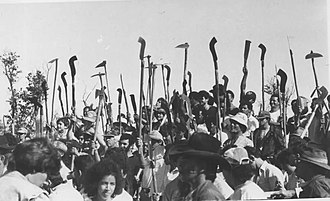Peasant leagues (Brazil)

Thepeasant leagues(Portuguese:ligas camponesas) were social organizations composed ofsharecroppers,subsistence farmersand other small agriculturalists. They originated in theagresteregion ofNortheastern Brazilin the 1950s, organized by theBrazilian Communist Party(PCB),[1]and were later picked up byFrancisco Julião,a member of theDemocratic Labor Party(PDT) and other socialists. The leagues were founded to improve rural workers' living standards; their later objective was to oppose the region's power oflatifundia.[2]
History
[edit]Brazilian communists founded the leagues, who believed that the latifundia, which had always dominated the Brazilian economy, were in asemicolonialrelationship with theUnited Statesand were conspiring to oppress the working class by forcing rural workers to producecash cropsinstead of food for native consumption and refusing to develop land which could not support those crops,[3]a belief partly shared by outsiders to communism.[4]The goal of the communists was to raise the rural workers' standard of living sufficiently so that a classic Marxist capitalist-to-socialist transition could occur.[5]
When the PCB began struggling with political pressure in the late 1950s, Francisco Julião began taking on the business of establishing and organizing leagues. In January 1955, Francisco Julião made one of the most important associations legal, the SAPPP[clarification needed],which used to fight for peasants' rights before its legalization.
Communists objected to his growing role in the movement. His attempts to unify the leagues and resistance to registering them as unions conflicted with their own goal of attaining legitimacy, and his use of violent revolutionary rhetoric made them worry about retaliation from the military and police.[6]
Reaction
[edit]The populist Brazilian government's attitude towards the leagues varied from neutral to positive over time, while that of the military and police was uniformly negative. The armed forces in the Brazilian Northeast had many connections to wealthy landowners whose enterprises were threatened by the activities of the leagues, and they would go to extraordinary lengths to curtail league activity.[7]TheCatholic Churchestablished organizations in the Northeast that functioned similarly but were conservative andanti-communistin their outlook; the armed forces crushed these groups alongside the peasant leagues following the1964 coup.[8]
See also
[edit]References
[edit]- ^Welch, Cliff.Keeping Communism Down on the Farm: The Brazilian Rural Labor Movement during the Cold War,Latin American Perspectives Vol.33, pg. 29.
- ^Welch, Cliff.Keeping Communism Down on the Farm: The Brazilian Rural Labor Movement during the Cold War,Latin American Perspectives Vol.33, pg. 28-50.
- ^Welch, Cliff.Keeping Communism Down on the Farm: The Brazilian Rural Labor Movement during the Cold War,Latin American Perspectives Vol.33, pg. 30.
- ^Smith, T. Lynn.Land Reform in Brazil,Luso-Brazilian ReviewVol. 1 No. 2.
- ^Welch, Cliff.Keeping Communism Down on the Farm: The Brazilian Rural Labor Movement during the Cold War,Latin American Perspectives Vol.33, pg. 30.
- ^Forman, Shepard.Disunity and Discontent: A Study of Peasant Political Movements in Brazil,Journal of Latin American StudiesVol.3, pp.14-16.
- ^Current Intelligence Weekly Summary 1 June 1962pg.7
- ^Wiarda, Iêda S. and Wiarda, Howard J.Revolution or Counter-Revolution in Brazil?,The Massachusetts ReviewVol. 8 No. 1.
